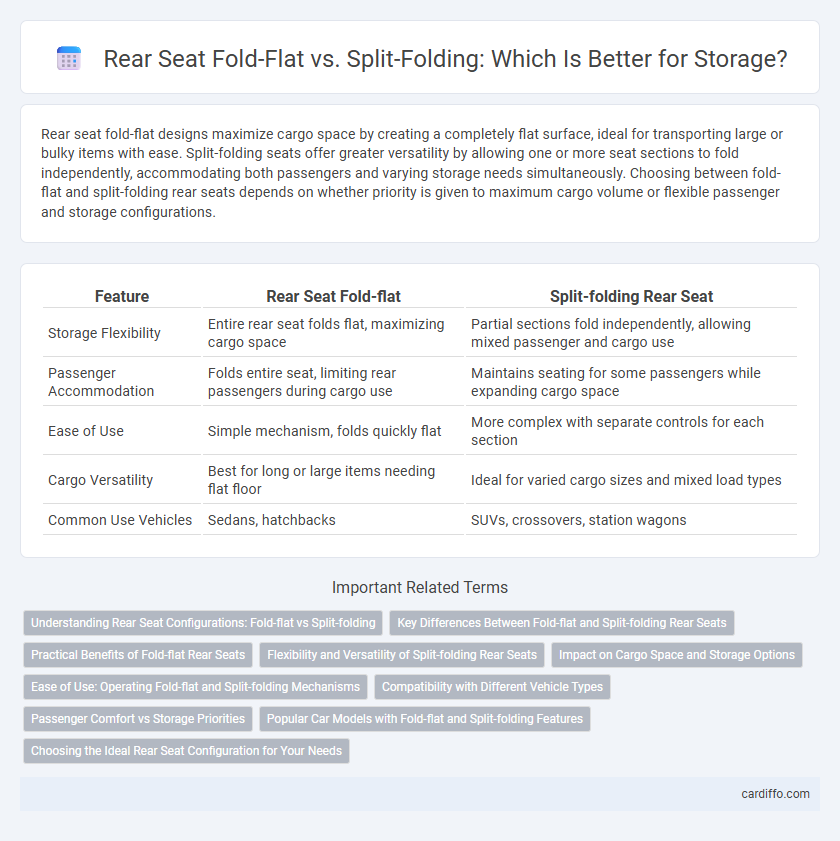Rear seat fold-flat designs maximize cargo space by creating a completely flat surface, ideal for transporting large or bulky items with ease. Split-folding seats offer greater versatility by allowing one or more seat sections to fold independently, accommodating both passengers and varying storage needs simultaneously. Choosing between fold-flat and split-folding rear seats depends on whether priority is given to maximum cargo volume or flexible passenger and storage configurations.
Table of Comparison
| Feature | Rear Seat Fold-flat | Split-folding Rear Seat |
|---|---|---|
| Storage Flexibility | Entire rear seat folds flat, maximizing cargo space | Partial sections fold independently, allowing mixed passenger and cargo use |
| Passenger Accommodation | Folds entire seat, limiting rear passengers during cargo use | Maintains seating for some passengers while expanding cargo space |
| Ease of Use | Simple mechanism, folds quickly flat | More complex with separate controls for each section |
| Cargo Versatility | Best for long or large items needing flat floor | Ideal for varied cargo sizes and mixed load types |
| Common Use Vehicles | Sedans, hatchbacks | SUVs, crossovers, station wagons |
Understanding Rear Seat Configurations: Fold-flat vs Split-folding
Rear seat configurations in vehicles offer distinct storage solutions: fold-flat seats create a continuous flat surface, maximizing cargo space for larger items, while split-folding seats allow independent folding of sections, enhancing versatility for mixed passenger and cargo needs. Fold-flat designs are ideal for transporting bulky gear with minimal gaps, whereas split-folding seats accommodate passengers and cargo simultaneously by folding only part of the rear seat. Understanding these configurations helps optimize vehicle storage based on specific user requirements and lifestyle demands.
Key Differences Between Fold-flat and Split-folding Rear Seats
Fold-flat rear seats offer a seamless, level cargo area by folding the entire rear bench down, maximizing storage space for large or bulky items. Split-folding rear seats, typically available in 60/40 or 40/20/40 configurations, allow independent folding of seat sections, providing flexibility to carry passengers and cargo simultaneously. The key difference lies in adaptability: fold-flat seats prioritize maximum flat space, while split-folding seats balance passenger accommodation with customizable storage options.
Practical Benefits of Fold-flat Rear Seats
Fold-flat rear seats enhance storage versatility by creating a seamless, flat load surface that maximizes cargo space, ideal for transporting larger items like furniture or sports equipment. Unlike split-folding seats, fold-flat designs eliminate gaps and uneven surfaces, making loading and unloading easier while protecting cargo from damage. This practical feature significantly improves vehicle functionality for daily errands, road trips, and moving bulky goods.
Flexibility and Versatility of Split-folding Rear Seats
Split-folding rear seats offer enhanced flexibility by allowing one or more seat sections to fold independently, adapting storage space to varying passenger and cargo needs. This versatility enables efficient use of the vehicle's interior, accommodating bulky items while still providing seating for passengers. The ability to customize the rear seat configuration improves overall utility, making split-folding seats ideal for drivers seeking practical storage solutions.
Impact on Cargo Space and Storage Options
Rear seat fold-flat designs maximize cargo space by allowing a completely flat surface from the trunk to the rear seats, creating a seamless storage area ideal for large and bulky items. Split-folding seats offer greater versatility by enabling independent folding of sections, allowing a mix of passengers and cargo while optimizing storage configuration. Vehicles with split-folding seats often include additional storage compartments and tie-down points, enhancing organizational options for diverse cargo needs.
Ease of Use: Operating Fold-flat and Split-folding Mechanisms
Fold-flat rear seats provide seamless storage expansion by allowing the entire seatback to fold down in one smooth motion, simplifying cargo loading and maximizing flat surface area. Split-folding rear seats offer versatile configurations by enabling independent operation of seat sections, accommodating varied passenger and cargo needs with straightforward latch or lever mechanisms. Both systems emphasize ergonomic design to minimize effort, but fold-flat seats generally deliver quicker transformation for enhanced ease of use in everyday scenarios.
Compatibility with Different Vehicle Types
Rear seat fold-flat configurations offer comprehensive flat loading surfaces ideal for hatchbacks and SUVs, enhancing storage capacity for bulky items. Split-folding seats provide versatile compatibility across sedans, crossovers, and compact cars by allowing partial seat folding to balance passenger seating and cargo space. Choosing between fold-flat and split-folding depends on the specific vehicle type and the need for flexible cargo management versus maximum flat storage.
Passenger Comfort vs Storage Priorities
Rear seat fold-flat designs enhance storage capacity by creating a seamless, extended cargo area, ideal for transporting larger items but may compromise passenger comfort due to limited seating flexibility. Split-folding rear seats provide balanced versatility, allowing one section to fold flat for additional storage while maintaining rear passenger seating, optimizing comfort and convenience. Choosing between fold-flat and split-folding configurations depends on prioritizing maximum storage space versus accommodating passenger comfort and varied seating needs.
Popular Car Models with Fold-flat and Split-folding Features
Popular car models like the Honda CR-V and Toyota RAV4 feature rear seat fold-flat designs, maximizing cargo space by creating a level loading floor for bulky items. In contrast, vehicles such as the Ford Escape and Subaru Outback offer split-folding rear seats, allowing flexible configurations for passengers and cargo simultaneously. These fold-flat and split-folding options enhance storage versatility, catering to different transportation needs in compact SUVs and crossovers.
Choosing the Ideal Rear Seat Configuration for Your Needs
Choosing between rear seat fold-flat and split-folding configurations depends on your cargo and passenger needs. Fold-flat seats provide a continuous, level surface ideal for maximizing storage space and transporting large items, while split-folding seats offer flexibility to carry passengers and vary cargo sizes simultaneously. Understanding the balance between full flatness for maximum volume and divisible sections for customizable arrangements ensures optimal vehicle storage utility.
Rear Seat Fold-flat vs Split-folding Infographic

 cardiffo.com
cardiffo.com